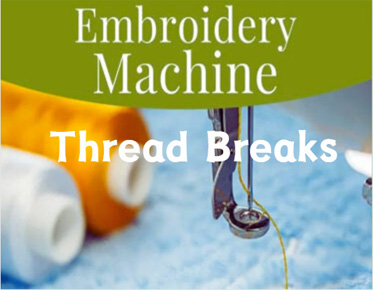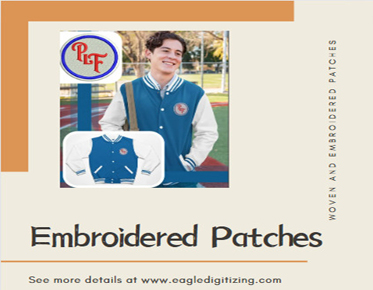From Snags to Success: Troubleshooting Embroidery Thread Problems
Embroidery, an age-old craft steeped in tradition and creativity, is an art form that relies heavily on the delicate interplay of various elements, with embroidery thread being at the forefront. Picture a scene where intricately woven patterns come to life on fabric, each stitch a testament to meticulous craftsmanship and attention to detail. Read Here are Some Things That You Should Know When It Comes To Embroidery Digitizing!
Embroidery enthusiasts understand all too well the pivotal role thread management plays in the success of their projects. Beyond merely serving as a conduit for stitches, the quality and condition of embroidery thread can make or break the final outcome. From the choice of thread to the maintenance of tension, every aspect of thread management contributes to the overall quality of the finished piece.
Thread Breakage
Imagine
the frustration of meticulously guiding your embroidery machine through a
complex pattern, only to be halted by the sudden snap of a thread. Embroidery Thread breakage, a common occurrence in
embroidery, can disrupt workflow and compromise the integrity of the design.
Thread
Shredding
Thread
shredding is akin to watching your carefully planned stitches unravel before
your eyes. It occurs when the thread frays or separates into thin strands,
diminishing the crispness of the design and leaving behind a jagged, uneven
finish.
Thread
Birdnesting
Picture
this: you're eagerly watching your embroidery machine at work, only to find a
tangled mess of thread forming beneath the fabric surface, resembling a chaotic
bird's nest. This frustrating phenomenon, known as birdnesting, can wreak havoc
on stitch accuracy and overall embroidery quality.
Thread Tension
Issues
Embroidery, like a delicate dance between thread and fabric, relies on the perfect balance of tension. When this equilibrium is disrupted, thread tension issues arise, leading to uneven stitches, puckering, or even thread breakage.
Machine-related Factors
Embroidery machines, marvels of modern
technology, are not immune to wear and tear. Mechanical issues such as
misalignment or insufficient lubrication can place undue stress on the thread,
resulting in breakage or shredding.
Thread Quality
Not all
threads are created equal. Inferior quality threads, with their uneven texture
and weak fibers, are more prone to breakage and shredding under the strain of
embroidery machine needles.
Needle-related Issues
The
humble needle, often overlooked yet essential, can also contribute to thread
woes. A dull or improperly sized needle can cause friction against the thread,
leading to shredding or breakage mid-stitch.
Complexity of Embroidery
Designs
While intricate designs are a testament to the embroiderer's skill and creativity, they also pose unique challenges. Dense stitching or frequent color changes can place excessive strain on the thread, leading to tension issues or breakage.
Adjusting Machine Settings
Fine-tuning
machine parameters such as tension, speed, and stitch length can alleviate
strain on the thread, reducing the likelihood of breakage during embroidery.
Using High-Quality Thread
Investing
in premium-quality thread, crafted from durable fibers and free from
imperfections, can significantly reduce the risk of breakage and ensure
smoother stitching.
Checking Needle Compatibility
Ensuring
that the needle is compatible with both the thread weight and fabric type is
crucial for preventing breakage. Using the correct needle size and type
minimizes friction and allows the thread to glide smoothly through the fabric.
Simplifying Design Complexity
While intricate designs may be visually stunning, they can also place undue stress on the thread. Simplifying designs by reducing stitch density or minimizing color changes can help alleviate strain and prevent breakage.
Needle Size Adjustment
Optimizing
the needle size to match the thread weight and fabric type can minimize
friction and reduce the likelihood of thread shredding during stitching.
Ensuring Proper Thread
Tension
Fine-tuning
the tension settings on the embroidery machine is crucial for preventing thread
shredding. Balancing the tension between the upper and lower threads ensures
smooth, even stitches without excessive strain on the thread.
Examining Thread Quality
Regularly inspecting the quality of the thread before use can help identify potential issues such as fraying or weak spots. Using high-quality thread with consistent texture and strength can minimize the risk of shredding during embroidery.
Bobbin Tension Adjustment
Calibrating
the tension of the bobbin thread to match the upper thread tension is essential
for preventing birdnesting. Adjusting the tension screws on the bobbin case can
help achieve the perfect balance between the two threads.
Bobbin Case Inspection
Regularly
cleaning and inspecting the bobbin case for debris or damage is crucial for
preventing birdnesting. A clean and properly adjusted bobbin case ensures
smooth thread delivery and reduces the risk of tangles or jams.
Utilizing Quality Bobbins
Using high-quality bobbins made from durable materials can help prevent birdnesting. Cheap or poorly made bobbins can warp or distort under tension, leading to erratic thread delivery and tangled stitches.
Understanding Tension
Settings
Embroidery
machines feature a variety of tension settings that control the tightness of
the stitches. Understanding how these settings work and how to adjust them is
crucial for achieving consistent stitch quality and preventing tension issues.
Regular Maintenance Checks
Routine
maintenance checks, including cleaning and lubricating the machine, are
essential for preventing tension issues. Dirt, lint, or debris buildup can
interfere with the thread path and cause tension irregularities.
Experimenting with Thread
Path
Exploring different thread paths within the embroidery machine can help troubleshoot tension issues. Sometimes, simply changing the way the thread is threaded through the machine can make a big difference in stitch quality.
Cleaning and Lubrication
Regular
cleaning and lubrication of the embroidery machine are essential for preventing
mechanical issues that can lead to thread problems. Dust, lint, and debris can
accumulate in the machine's moving parts, causing friction and wear over time.
Needle Replacement
Replacing
the needle regularly is important for maintaining stitch quality and preventing
thread breakage. Dull or damaged needles can snag or shred the thread,
resulting in uneven stitches and embroidery defects.
Machine Calibration
Calibrating the embroidery machine regularly ensures that all settings are correctly adjusted for optimal performance. This includes adjusting tension, stitch length, and other parameters to match the thread and fabric being used.
Preventing Fraying
Metallic
thread is prone to fraying due to its unique composition and texture. Using a
specialized metallic thread needle and adjusting the tension settings can help
minimize fraying and ensure smooth stitching.
Minimizing Breakage
To
prevent breakage, it's important to use a slow stitching speed when working
with metallic thread. Abrupt changes in direction or excessive tension can
cause the thread to snap, leading to stitching errors and frustration.
Avoiding Needle Damage
Regularly inspecting needles for burrs or rough edges prevents abrasion-induced damage to delicate metallic threads, ensuring smooth stitching.
Rayon Thread Troubleshooting
Rayon
threads, known for their vibrant sheen and smooth texture, require special
attention to prevent breakage and shredding. Adjusting tension settings and
using a smaller needle size minimizes friction and ensures optimal performance
with rayon threads.
Polyester Thread Concerns
Polyester
threads, prized for their durability and colorfastness, may pose challenges
such as tension issues and thread breakage. Using a thread lubricant and
adjusting machine settings mitigates these concerns, ensuring consistent
stitching with polyester threads.
Variegated Thread Challenges
Variegated threads, with their color-changing properties, add depth and dimension to embroidery designs but may present challenges in maintaining consistent tension. Experimenting with tension settings and conducting test stitches helps achieve uniform stitching with variegated threads.
Adjusting Thread Tension
In the
intricate dance of color matching, thread tension plays a pivotal role. By
delicately adjusting tension settings, embroiderers can rectify color distortions
caused by uneven thread distribution. This meticulous calibration ensures that
each hue is rendered with precision, contributing to the overall vibrancy and
accuracy of the design.
Using Thread Converter Charts
Navigating
the vast spectrum of thread colors across different brands can be akin to
deciphering a complex code. Fortunately, thread converter charts serve as
invaluable guides, facilitating seamless transitions between thread brands
while maintaining color consistency. By referencing these charts, embroiderers
can effortlessly match shades, ensuring harmonious blends and cohesive
compositions in their creations.
Testing Thread Colors Before
Stitching
Embarking on an embroidery project without prior color testing is akin to traversing uncharted waters without a compass. To preempt color discrepancies and ensure fidelity to the intended palette, it is essential to conduct thorough testing with sample threads. By stitching small swatches and scrutinizing the results under various lighting conditions, embroiderers can fine-tune their color selections, guaranteeing flawless execution and visual coherence in the final product.
Consulting Machine
Technicians
In the
labyrinth of embroidery machine intricacies, navigating alone can be daunting.
When confronted with perplexing technical issues beyond their expertise,
embroiderers can turn to seasoned machine technicians for guidance. These
professionals possess the specialized knowledge and diagnostic skills to
troubleshoot complex machinery malfunctions, offering invaluable insights and
solutions to restore seamless operation. By entrusting their machines to
capable hands, embroiderers can alleviate frustration and expedite the
resolution of technical challenges, allowing them to focus on their creative
endeavors with confidence and peace of mind.
Contacting Thread
Manufacturers
Amidst the myriad of thread-related quandaries, direct communication with thread manufacturers emerges as a beacon of clarity. By reaching out to these experts in the field, embroiderers can gain invaluable insights into thread-specific concerns and best practices. Whether seeking guidance on thread selection, troubleshooting compatibility issues, or deciphering cryptic labeling, manufacturers stand ready to provide tailored assistance and expert advice. Through proactive engagement with thread manufacturers, embroiderers can unlock a wealth of knowledge, fostering a deeper understanding of thread properties and techniques to enhance their craft.
Embroidery,
with its intricate interplay of threads and colors, is a testament to the
fusion of artistry and technique. While the journey may be fraught with
challenges, armed with knowledge and perseverance, embroiderers can overcome
any obstacle that stands in their path. By understanding the root causes of
common thread problems and employing effective troubleshooting strategies, they
can elevate their craft to new heights of excellence. With each stitch, they
weave not just fabric, but stories and emotions, leaving an indelible mark on
the canvas of creativity. So, let us thread our needles, embark on this journey
of discovery, and transform challenges into triumphs, one stitch at a time,
with the support of Eagle Digitizing's professional embroidery digitizing services.



